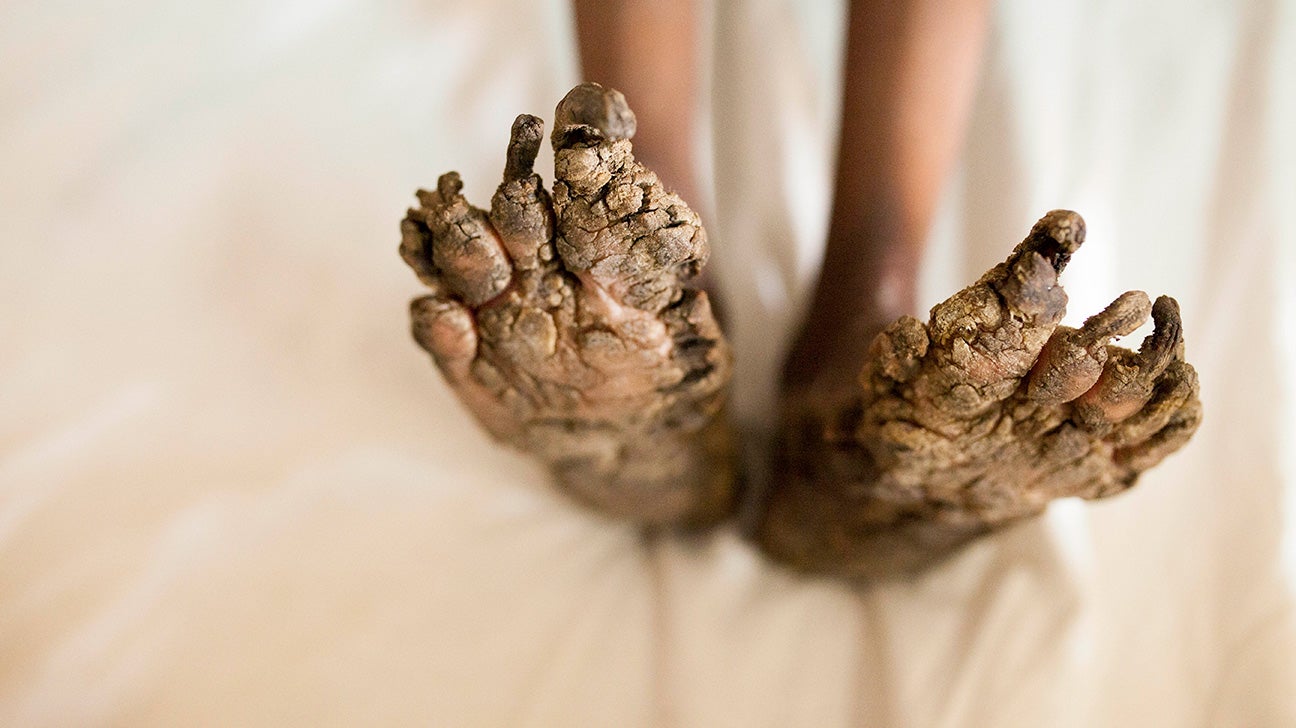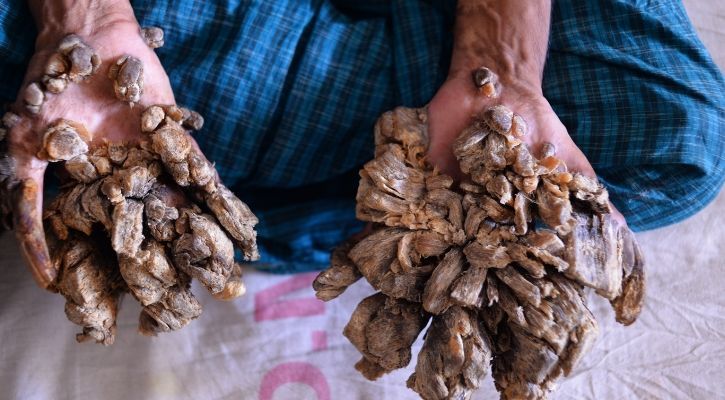Is tree man syndrome genetic ?
TREE MAN SYNDROME [EPIDERMODYSPLASIA VERRUCIFORMIS ] :
Epidermodysplasia verruciformis (EV) is an extremely rare skin condition that can cause bark-like growths.
While the exact prevalence of EV is unclear, there have been more than 200 reported cases, the Genetic and Rare Diseases Information Center (GARD) note. EV is an inherited genetic immune disorder. It makes people extremely susceptible to human papillomarvirus infections .
Over time, the infection causes skin growths, such as viral warts and pigmented, inflamed patches. In severe or extreme cases, a person may develop bark-like growths. HPV is contagious and usually transmitted through skin-to-skin contact. A person can pass it on even if they experience no symptoms.
When EV is severe enough to cause bark-like growths, it is sometimes colloquially called “tree man syndrome.” This is a misnomer for obvious reasons, but also because it affects both males and females.
What are the sign and symptoms of epidermodysplasia verruciformis ?
The most striking symptom of EV is bark-like growths of tissue, which most commonly develop on the hands and feet. However, it is important to note that this is a severe presentation.
People with EV tend to develop :
- small pink, white, reddish-brown, dark brown, or violet growths called papules, which may be raised and flat-topped
- larger scaly, raised, or inflamed patches of skin called plaques, which may have irregular edges
- raised brown growths called viral warts
The warts tend to occur in clusters of a few to more than 100 lesions each. They commonly form on areas exposed to the sun, including the:
- hands
- feet
- earlobes
- face
Larger plaques associated with EV tend to form on the:
- neck
- arms
- legs
- trunk
However, people with EV can experience symptoms anywhere, including the:
- soles of the feet
- armpits
- external genitalia
- palms
According to the GARD, approximately 61.5% of people diagnosed with EV develop symptoms in childhood, while some 22% develop them during puberty and 7.5% do so in infancy.
What are the causes of epidermodysplasia verruciformis ?
EV is an autosomal recessive genetic disorder, meaning that it results from mutations at specific locations on certain genes, and that the person has inherited the same mutations from both parents.
In about 10% of EV cases, the person’s parents were relatives.
Rarely, the condition can either be linked to sex, in the sense that the mutation developed on the X or Y genes, or it can be autosomal dominant — caused by a single mutated gene.
Also, acquired EV has developed in people with:
According to the GARD, EV seems to occur due to a loss-of-function mutation in one of two adjacent genes, called EVER1/TMC6 and EVER2/TMC8.
These genes help facilitate the transportation of zinc in skin cells. Zinc, meanwhile, plays an important
Some research indicates that the mutations linked with EV may make it easier for the virus to access cellular zinc stores.
The GARD also note that mutations associated with EV seem to make people extremely susceptible to infections with beta forms of HPV, which usually do not cause infection in healthy people.
Researchers have linked roughly 30 subtypes of HPV to EV, though around 80% of known cases involved types 5 and 8.
How to prevent epidermodysplasia verruciformis ?
As EV is an inherited condition, a person is not able to prevent it from developing.
However, a person can take certain steps to reduce symptoms and help limit the chances of the lesions becoming cancerous.
Though there is no cure for EV, some medications, therapies, and lifestyle changes may help make symptoms more manageable and reduce the chances of complications.
Medical management optins include:
- Systemic or topical retinoids: These medications may help prevent an HPV infection from spreading and reduce skin inflammation Taking 0.5 to 1.0 milligrams of acitretin daily for 6 months may be the most effective treatment.
- Interferon-alpha: This contains a natural compound that reduces cell growth and division, especially in cancer cells. It can also help treat viral infections.
- Cholecalciferol: This medication is similar to vitamin D
Lifestyle changes that may help include:
- Sun avoidance or protection: Avoiding sun exposure, covering up as much as possible, and wearing sunscreen may help prevent skin cancer from developing.
- Quit smoking: Smoking increases the risk of developing several types of cancer and reduces overall immune function.
Also, a doctor may recommend the following ways to remove growths :
- Cryotherapy: This involves freezing off growths.
- Laser surgery or electrosurgery: These employ either lasers or high-frequency electrical currents to remove or destroy growths and other lesions.
If a growth is cancerous, a doctor may recommend surgery to remove it. In some cases, this requires a skin graft.
Lesions will continue to develop throughout a person’s life.



Comments
Post a Comment